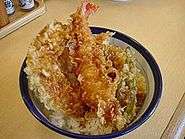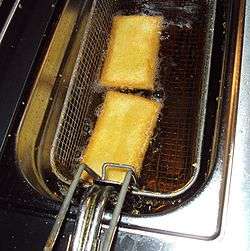Tempura
Tempura (天ぷら or 天麩羅 tenpura, [tẽ̞mpɯᵝra]) is a Japanese dish of seafood or vegetables that have been battered and deep fried.
Preparation
Batter
A light batter is made of cold water (sometimes sparkling water is used to keep the batter light)[1] and soft wheat flour (cake, pastry or all-purpose flour).[2][3][4] Eggs, baking soda or baking powder, starch, oil, and/or spices may also be added. Tempura batter is traditionally mixed in small batches using chopsticks for only a few seconds, leaving lumps in the mixture that, along with the cold batter temperature, result in the unique fluffy and crisp tempura structure when cooked. The batter is often kept cold by adding ice, or by placing the bowl inside a larger bowl with ice in it. Overmixing the batter will result in activation of wheat gluten, which causes the flour mixture to become soft and dough-like when fried.
Specially formulated tempura flour is available in worldwide supermarkets. This is generally light (low-gluten) flour, and occasionally contains leaveners such as baking powder.
Tempura generally does not use breadcrumbs (panko) in the coating. Generally, fried foods which are coated with breadcrumbs are considered to be furai, Japanese-invented Western-style deep fried foods, such as tonkatsu or ebi furai (fried prawn).
Frying
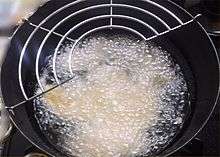
Thin slices or strips of vegetables or seafood are dipped in the batter, then briefly deep-fried in hot oil. Vegetable oil or canola oil are most common; however, tempura was traditionally cooked using sesame oil. Many specialty shops still use sesame oil or tea seed oil, and it is thought certain compounds in these oils help to produce light, crispier batter.
When cooking shellfish, squid, or hard-skinned watery vegetables, such as bell pepper or eggplant, the skin is usually scored with a knife to prevent the ingredients from bursting during cooking, which can cause serious burns from splashing oil.
Oil temperature is generally kept between 160 and 180 degrees Celsius (320-356 F), depending on the ingredient. To preserve the natural flavor and texture of the ingredients, care is taken not to overcook tempura. Cooking times range between a few seconds for delicate leaf vegetables, to several minutes for thick items or large kaki-age fritters.
The bits of batter (known as tenkasu) are scooped out between batches of tempura, so they do not burn and leave a bad flavor in the oil. A small mesh scoop (Ami jakushi) is used for this purpose. Tenkasu are often reserved as ingredients in other dishes or as a topping.
Ingredients
Various seafood and vegetables are commonly used as the ingredients in traditional tempura.
Seafood

The most popular seafood tempura is probably ebi (shrimp) tempura. Types of seafood used in tempura includes:
|
Vegetables
.jpg)
Vegetables tempura is called yasai tempura. The all vegetable tempura might be served as a vegetarian dish. Types of vegetables includes:
|
Serving and presentation
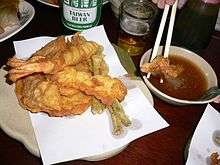
Cooked bits of tempura are either eaten with dipping sauce, salted without sauce, or used to assemble other dishes. Tempura is commonly served with grated daikon and eaten hot immediately after frying. In Japan, it is often found in bowls of soba or udon soup often in the form of a shrimp, shiso leaf, or fritter. The most common sauce is tentsuyu sauce (roughly three parts dashi, one part mirin, and one part shoyu). Alternatively, tempura may be sprinkled with sea salt before eating. Mixtures of powdered green tea and salt or yuzu and salt are also used.
Kakiage is a type of tempura made with mixed vegetable strips, such as onion, carrot, and burdock, and sometimes including shrimp or squid, which are deep fried as small round fritters.
Tempura is also used in combination with other foods. When served over soba (buckwheat noodles), it is called tempura soba[5] or tensoba. Tempura is also served as a donburi dish where tempura shrimp and vegetables are served over steamed rice in a bowl (tendon) and on top of udon soup (tempura udon).
History
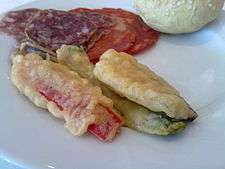
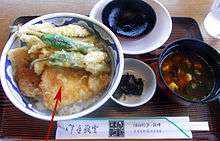
Origins
Japanese ancient deep-fried food was either simply fried without breading or batter or fried with rice flour. However, toward the end of the 16th century, a method using flour and eggs as a batter was acquired from the Portuguese merchants who resided in Nagasaki and made fritters. In those days, tempura in Nagasaki was deep-fried in lard with a batter consisting of flour, eggs, sugar, salt and sake and resembled fritters as the batter was thick, tasted heavy and was eaten without being dipped in a sauce.
In the beginning of the 17th century around the Tokyo Bay areas, raw materials of tempura and its method underwent a remarkable change as the Yatai culture (a food stall culture) gained more popularity. Making the best use of fresh seafood while keeping the integrity of the delicate taste of seafood, tempura used only flour, eggs and water as ingredients and the batter was not flavored. As the batter was mixed minimally in cold water, it avoided the dough-like stickiness caused by the activation of wheat gluten and resulted in crispy texture which is a characteristic of tempura. It became customary to eat it by dipping quickly in the sauce mixed with grated daikon just before it was eaten. Today in Japan the mainstream of tempura recipes basically originates from “the Tokyo style (Edo style) tempura” which was invented at the food stalls along the riverside fish market in the Edo period.
There are several factors for the popularization and flourishing of tempura at Tokyo Bay in the Edo period. The abundance of seafood in the Tokyo Bay is the basic factor. In addition, as oil extraction techniques advanced, cooking oil became inexpensive. In those days, serving deep-fried foods indoors was prohibited in Edo due to a possible fire hazard. Traditional Japanese housing was constructed with paper and wood which could catch fire easily from the tempura oil. For that reason, tempura gained popularity as fast food eaten outside at the food stall. Eating tempura in those days was made to be convenient like fast food as tempura was skewered and eaten with a dipping sauce. Tempura has been considered as one of “the Edo Delicacies” along with soba (buckwheat noodles) and sushi which were also food stall take outs. The modern tempura recipe was first published in 1671 in the cook book called “料理献立抄.” After the Meiji period, tempura was no longer considered as a fast food item but instead developed as a high-class cuisine.
Etymology
| Look up tempura in Wiktionary, the free dictionary. |
The word "tempura", or the technique of dipping fish and vegetables into a batter and frying them, comes from the word "tempora", a Latin word meaning "times", "time period" used by both Spanish and Portuguese missionaries to refer to the Lenten period or Ember Days (ad tempora quadragesimae), Fridays, and other Christian holy days. Ember Days or quattuor tempora refer to holy days when Catholics avoid red meat and instead eat fish or vegetables.[6] The idea that the word "tempura" may have been derived from the Portuguese noun tempero, meaning a condiment or seasoning of any kind, or from the verb temperar, meaning "to season" has not been substantiated.[7] However, the Japanese language could easily have assumed the word "tempero" as is, without changing any vowels as the Portuguese pronunciation in this case is similar to the Japanese.[8] There is still today a dish in Portugal very similar to tempura called peixinhos da horta, "garden fishies.", which consists in green beans dipped in a batter and fried. The end result is usually chewier than tempura.
It is also possible that the Portuguese picked the technique up from Goa which was their colony in India and this could very well be a variation of the pakora.
The term "tempura" is thought to have gained popularity in southern Japan; it became widely used to refer to any sort of food prepared using hot oil, including some already existing Japanese foods. Today, the word "tempura" is also commonly used to refer to satsuma age, a fried fish cake which is made without batter.
Variations
Japan
In Japan, restaurants specializing in tempura are called tenpura-ya and range from inexpensive fast food chains to very expensive five-star restaurants. Many restaurants offer tempura as part of a set meal or a bento (lunch box), and it is also a popular ingredient in take-out or convenience store bento boxes. The ingredients and styles of cooking and serving tempura vary greatly through the country, with importance being placed on using fresh, seasonal ingredients.
Outside Japan
.jpg)
Outside Japan (as well as recently in Japan), there are many nontraditional and fusion uses of tempura. Chefs over the world include tempura dishes on their menus, and a wide variety of different batters and ingredients are used, including the nontraditional broccoli, zucchini, asparagus and chuchu. More unusual ingredients may include nori slices, dry fruit such as banana, and ice cream (tempura-based fried ice cream). American restaurants are known to serve tempura in the form of various meats, particularly chicken, and cheeses, usually mozzarella. A variation is to use panko (breadcrumbs), which results in a crisper consistency than tempura batter. Using panko in Japan would no longer qualify the dish as tempura. It would become something else called fry or pronounced in Japanese as furai. Tempura (particularly shrimp) is often used as a filling in makizushi. A more recent variation of tempura sushi has entire pieces of sushi being dipped in batter and tempura-fried.
In Bangladesh the blossoms of pumpkins or marrows are often deep fried with a gram of rice flour spice mix creating a Bengali style tempura known as kumro ful bhaja.
Taiwan
In Taiwan, tempura as described in the preceding is known as tiānfùluō (天婦羅) and can commonly be found on the menu in Japanese restaurants all over the island. A similar-sounding dish, tiánbùlà (甜不辣) (lit. sweet, not spicy) is usually sold at night markets; it bears no resemblance whatsoever with tempura, but can be considered a counterpart to Japanese oden.
See also
- Japanese words of Portuguese origin
- kushikatsu
- Tonkatsu, a Japanese deep fried pork cutlet
- Pakora, an Indian food resembling tempura
References
- ↑ fishcooking.about.com
- ↑ Okamoto, Osamu (1994). Sam Okamoto's incredible vegetables. Pelican Publishing Company. p. 31. ISBN 1-56554-025-5.
- ↑ Meyer, Arthur L.; Vann, Jon M. (2003). The Appetizer Atlas: A World of Small Bites. John Wiley and Sons. p. 235. ISBN 0-471-41102-7.
- ↑ Kobayashi, Katsuyo (2000). The quick and easy Japanese cookbook: great recipes from Japan's favorite TV cooking show host. Kodansha International. p. 23. ISBN 4-7700-2504-1.
- ↑ "Tempura Soba". Authentic Recipe List. Asian Inspiretion. Retrieved 6 November 2015.
- ↑ Narloch, Leandro (2013). "Samurais". Guia Politicamente Incorreto da História do Mundo (in Portuguese) (1 ed.). São Paulo: Editora Leya. p. 163. ISBN 9788580448405.
- ↑ Morieda, Takashi. "Tracking Down Tempura". The World of Kikkoman. Retrieved 2007-12-13.
- ↑ "Japanese Writers' House Newsletter". 2007-10-10. Retrieved 2008-01-11.
| Wikibooks Cookbook has a recipe/module on |
| Wikimedia Commons has media related to Tempura. |
